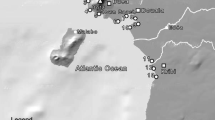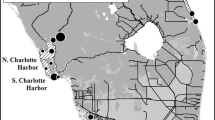Abstract
Hurricane Katrina made landfall on August 29, 2005 and caused widespread devastation along the central Gulf Coast states. Less than a month later Hurricane Rita followed a similar track slightly west of Katrina’s. A coordinated multi-agency response followed to collect water, sediment and tissue samples for a variety of chemical, biological and toxicological indicators. The National Oceanic and Atmospheric Administration’s National Status and Trends Program (NS&T) participated in this effort by measuring chemical contamination in sediment and oyster tissue as part of the Mussel Watch Program, a long-term monitoring program to assess spatial and temporal trends in a wide range of coastal pollutants. This paper describes results for contaminants measured in oyster tissue collected between September 29 and October 10, 2005 and discusses the results in the context of Mussel Watch and its 20-year record of chemical contamination in the region and the nation. In general, levels of metals in oyster tissue were higher then pre- hurricane levels while organic contaminants were at or near record lows. No contaminant reported here exceeded the FDA action level for food safety.
Similar content being viewed by others
References
Apeti, D. A., Robinson, L., & Johnson, E. (2005). Relationships between heavy metal concentration in the American oyster (Crassostrea virginica) and metal levels in the water column and sediment in Apalachicola Bay, Florida. American Journal of Environmental Sciences, 1(3), 179–186.
Balthis, W. L., Hyland, J. L., & Bearden, D. W. (2006). Ecosystem responses to extreme natural events: Impacts of three sequential hurricanes in fall 1999 on sediment quality and condition of benthic fauna in the Neuse River Estuary, North Carolina. Environmental Monitoring and Assessment, 119, 367–389.
Blake, E. S., Rappaport, E. N., & Landsea, C. W. (2007). The deadliest, costliest, and most intense United States tropical cyclones from 1985 to 2006 (and other frequently requested hurricane facts). NOAA Technical Memorandum NWS TPC-5. Updated April 2007. National Weather Service, National Hurricane Center, Miami, FL.
CRS (2006). Cleanup after hurricane Katrina: environmental considerations. Congressional Research Service Report for Congress, RL33115. May 3, 2006. pp32.
Dean, C. M., Sanalone, J. J., Cartledge, F. K., & Pardue, J. H. (2005). Influence of hydrology on rainfall-runoff metal element speciation. Journal of Environmental Engineering, 131, 633–642.
Dortch, M. S., Zakikhani, M., & Kim, S. C. (2006). Contaminant fate/transport modeling for environmental consequences of IPET Task 9. Technical Report (ERDC/EL TR-06-9). Vicksburg, MS: U.S. Army Engineer Research and Development Center. Retrieved January 11, 2008, from http://el.erdc.usace.army.mil/elpubs/pdf/trel06-9.pdf.
EPA (2004). National recommended water quality criteria; EPA-822-F-04-010; U.S. EPA, Office of Water. Washington, DC, 23pp.
EPA (2005). Report, Post-Katrina NPL and Non-NPL superfund site evaluations, Southern and Coastal Alabama and Mississippi, October 2005. Retrieved January 11, 2008, from http://www.epa.gov/region04/sesd/reports/2006-0139/katrina.nplreport.final.12-29w.pdf.
Frazier, J. M. (1975). The dynamics of metals in the American oyster, Crassostrea virginica. I. Seasonal effects. Chesapeake Science, 16(3), 162–171.
Gambrell, R. P., Wiesepape, J. B., Patrick, W. H. Jr., & Duff, M. C. (1991). The effects of pH, redox, and salinity on metal release from contaminated sediment. Water, Air, and Soil Pollution, 57–58(1), 359–367.
Goldberg, E. D., Koide, M., Hodges, V., Flegal, A. R., & Martin, J. H. (1983). US Mussel Watch: 1977–1978 results on trace metals and radionuclides. Estuarine, Coastal and Shelf Science, 16, 69–93.
Greening, H., Doering, P., & Corbett, C. (2006). Hurricane impacts on coastal ecosystems. Estuaries and Coasts, 29, 919–925.
Guo, T. Z., DeLaune, R. D., & Patrick, W. H. Jr. (1997). The influence of sediment redox chemistry on chemically active forms of arsenic, cadmium, chromium, and zinc in estuarine sediment. Environment International, 23(3), 305–316.
Guo, L., Hunt, B. J., Santschi, P. H., & Ray, S. (2001). Effect of dissolved organic matter on the metal uptake by American oysters. Environmental Science & Technology, 35(5), 885–893.
Guo, L., Santschi, P. H., & Ray, S. M. (2002). Metal partitioning between colloidal and dissolved phases and its relation with bioavailability to American oysters. Marine Environmental Research, 54, 49–64.
Hagy, J. D. III, Lehrter, J. C., & Murrell, M. C. (2006). Effects of Hurricane Ivan on water quality in Pensacola Bay, FL USA. Estuaries and Coasts, 29, 919–925.
Karikoff, S. W. (1984). Organic pollutant sorption in aquatic systems. Journal of Hydraulic Engineering, 110(6), 707–735.
Kim, Y., Ashton-Alcox, K. A., & Powell, E. N. (2006). Histological techniques for marine bivalve molluscs: Update. Silver Spring, MD. NOAA Technical Memorandum NOS NCCOS 27.
Kimbrough, K. L., & Lauenstein, G. G. (2006). Trace metal analytical methods of the national status and trends program: 2000–2006. Silver Spring, MD. NOAA Technical Memorandum NOS NCCOS 29.
Kimbrough, K. L., Lauenstein, G. G., & Johnson, W. E. (Eds.) (2006). Organic contaminant analytical methods of the national status and trends program: Update 2000–2006. NOAA Technical Memorandum NOS NCCOS 30.
Kucklick, J. R., Sivertsen, S., Sanders, M., & Scott, G. (1997). Factors influencing polycyclic aromatic hydrocarbon concentrations and patterns in South Carolina sediments. Journal of Experimental Marine Biology and Ecology, 213, 13–29.
Lauenstein, G. G., & Cantillo, A. Y. (1993a). Sampling and analytical methods of the National Status and Trends Program National Benthic Surveillance and Mussel Watch Projects 1984–1992: overview and summary of methods, Volume I NOAA Technical Memorandum NOS ORCA 71, Silver Spring, MD.
Lauenstein, G. G., & Cantillo, A. Y. (Eds.) (1993b). Sampling and analytical methods of the National Status and Trends Program National Benthic Surveillance and Mussel Watch Projects 1984–1992: comprehensive descriptions of complementary measurements, Volume II NOAA Technical Memorandum NOS ORCA 71, Silver Spring, MD.
Lauenstein, G. G., & Cantillo, A. Y. (Eds.) (1993c). Sampling and analytical methods of the National Status and Trends Program National Benthic Surveillance and Mussel Watch Projects 1984–1992: Comprehensive descriptions of elemental analytical methods, Volume III NOAA Technical Memorandum NOS ORCA 71, Silver Spring, MD.
Lauenstein, G. G., & Cantillo, A. Y. (Eds.) (1993d). Sampling and analytical methods of the National Status and Trends Program National Benthic Surveillance and Mussel Watch Projects 1984–1992: Comprehensive descriptions of trace organic analytical methods, Volume IV NOAA Technical Memorandum NOS ORCA 71, Silver Spring, MD.
Lauenstein, G. G., & Cantillo, A. Y. (Eds.) (1998). Sampling and Analytical Methods of the National Status and Trends Program Mussel Watch Project: 1993–1996 Update, NOAA Technical Memorandum ORCA 130, Silver Spring, MD.
McDonald, S. J., Frank, D. S., Ramirez, J. A., Wang, B., & Brooks, J. M. (2006). Ancillary Methods of the National Status and Trends Program: 2000–2006 Update. Silver Springs, MD. NOAA Technical Memorandums NOS NCCOS 28.
Meade, R. H. (1995). Contaminants in the Mississippi River, 1987–1992; U.S. Geological Survey Circular 1133; U.S. Geological Survey, Reston, VA.
Means, J. C. (1995). Influence of salinity upon sediment–water partitioning of aromatic hydrocarbons. Marine Chemistry, 51, 3–16.
Millward, G. E., & Liu, Y. P. (2003). Modeling metal desorption kinetics in estuaries. Science of the Total Environment, 314–316, 613–623.
O’Connor, T. P., & Lauenstein, G. G. (2006). Trends in chemical concentrations in mussels and oysters collected along the US coast: Update to 2003. Marine Environmental Research, 62, 261–285.
Pardue, J. H., Moe, W. M., McInnis, D., Thibodeaux, L. J., Valsaraj, K. T., Maciasz, E., et al. (2005). Chemical and microbiological parameters in New Orleans floodwater following Hurricane Katrina. Environmental Science & Technology, 39, 8591–8599.
Phillips, P. T. (1988). California State Mussel Watch ten year data summary, 1977–1987. Water Quality Monitoring Report No. 87-3, Division of Water Quality, State Water Resources Control Board.
Roffer, M. A. (2008). Roffer’s Ocean Fishing Forecasting Services, Inc. Retrieved January 11, 2008, from http://www.roffs.com/katrina.htm.
Steward, J. S., Virnstein, R. W., Lasi, M. A., Morris, L. J., Miller, J. D., Hall, L. M., et al. (2006). The impacts of the 2004 hurricanes on hydrology, water quality, and seagrass in the Central Indian River Lagoon, Florida. Estuaries and Coasts, 29, 954–965.
Tenor, K. R., & Dunstan, W. M. (1973). Comparison of feeding and biodeposition of three bivalves at different food levels. Marine Biology, 21(3), 190–195.
Thompson, R. E., Voit, E. O., & Scott, G. I. (2000). A probabilistic model for predicting distributions of PAH ratios between oysters and marine sediments. Ecological Modelling, 135, 231–242.
Turner, A. (2003). Salting out of chemicals in estuaries: Implications for contaminant partitioning and modeling. Science of the Total Environment, 314–316, 599–612.
USDOC (2007). Report to Congress on the Impact of Hurricanes Katrina, Rita, and Wilma on Commercial and Recreational Fishery Habitat of Alabama, Florida, Louisiana, Mississippi, and Texas. US Dept of Commerce, National Oceanic and Atmospheric Administration, National Marine Fisheries Service. Silver Spring, MD. pp. 200.
Van Metre, P. C., Horowitz, A. J., Mahler, B. J., Foreman, W. T., Fuller, C. C., Burkhart, M. R., et al. (2006). Effects of Hurricanes Katrina and Rita on the chemistry of bottom sediments in Lake Pontchartrain, Louisiana, USA. Environmental Science & Technology, 40, 6894–6902.
Ward, J. E., & Shumway, S. E. (2004). Separating the grain from the chaff: Particle selection in suspension- and deposit-feeding bivalves. Journal of Experimental Marine Biology and Ecology, 300, 83–130.
Author information
Authors and Affiliations
Corresponding author
Rights and permissions
About this article
Cite this article
Johnson, W.E., Kimbrough, K.L., Lauenstein, G.G. et al. Chemical contamination assessment of Gulf of Mexico oysters in response to hurricanes Katrina and Rita. Environ Monit Assess 150, 211–225 (2009). https://doi.org/10.1007/s10661-008-0676-9
Received:
Accepted:
Published:
Issue Date:
DOI: https://doi.org/10.1007/s10661-008-0676-9




